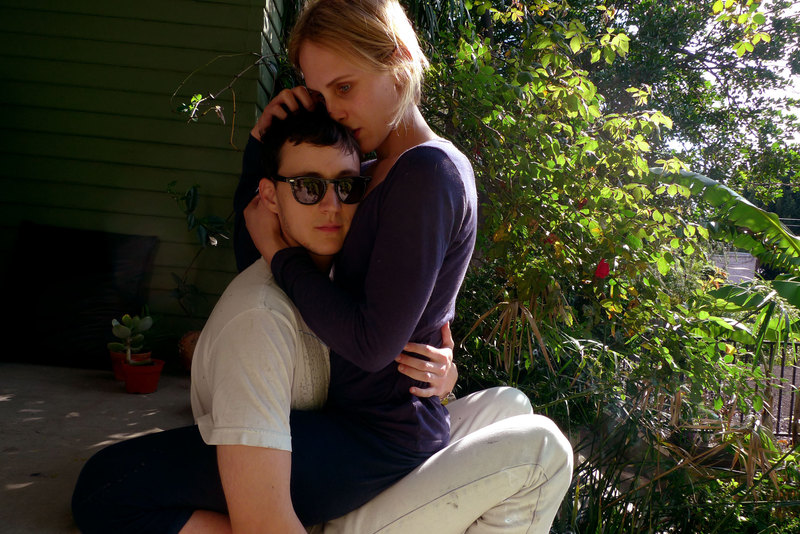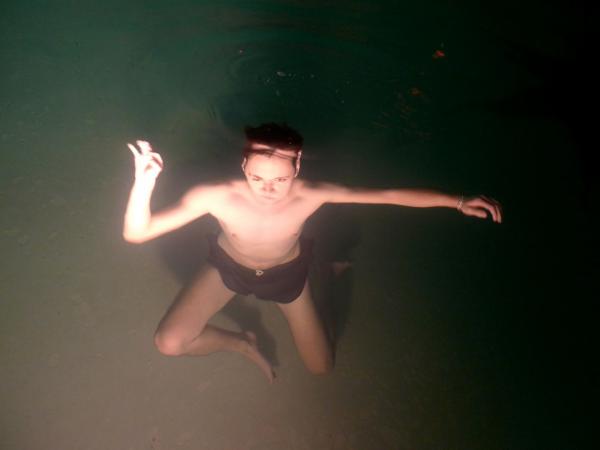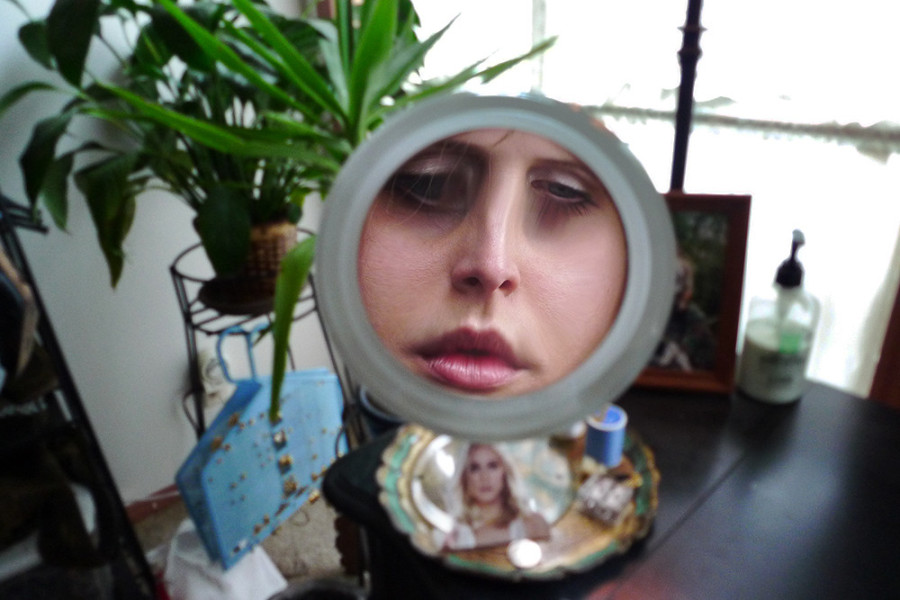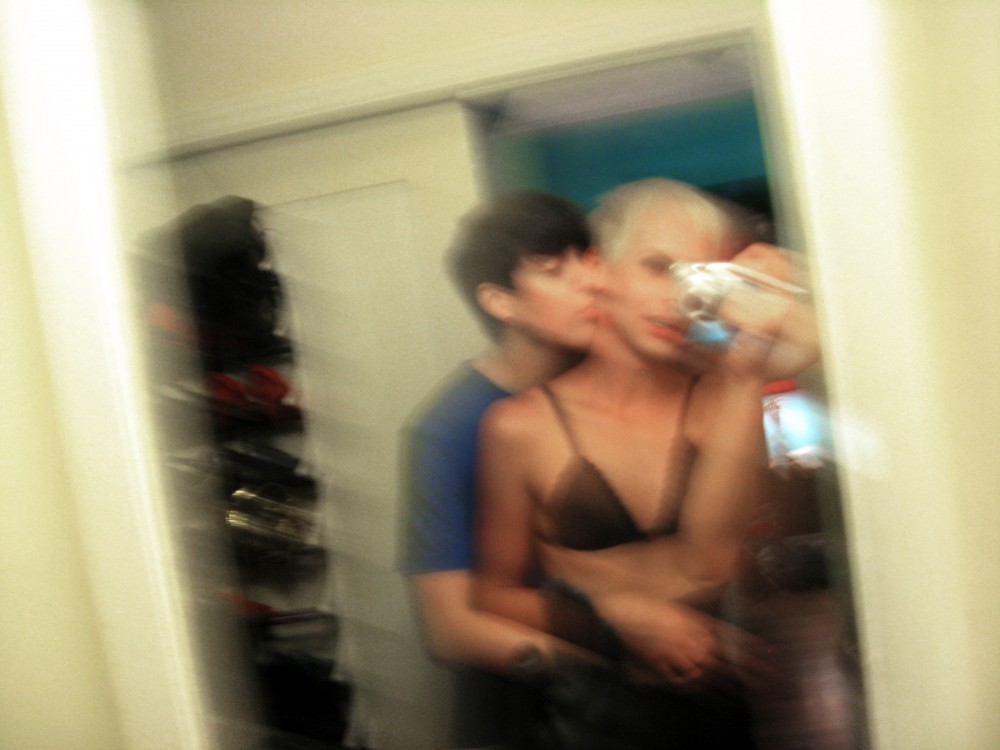John Hutt: Over what period were the pictures shot?
Zackary Drucker: The earliest images are from 2008 and the latest ones were taken this past summer: 2013.
Rhys Ernst: We started taking pictures at the very beginning of our relationship, and continue to. We took a picture of ourselves this morning when we woke up.
The pictures are all very tender, your relationship is clearly strong – did you discuss sharing all this with the world, or did it simply seem the natural thing to do?
ZD: Relationship began as a purely diaristic series of documents-- snapshots of our lives together. When we met we quickly fell into a romantic relationship, which was unexpected because it differed so much from our respective dating histories. We felt this magical sort-of pre-destined connection, and simultaneously we were so captivated by the image we created together. The first image of us ever taken is in the exhibition - it’s an image of us in the mirror. Also, when one transitions, your self-image is aligning with your physical image, which is like a dream becoming reality. It was never our intention to show the images to anyone, but after 5 years we realized that we had this incredible archive. The passing of time had a cumulative effect, rounding out our narrative arc and offering us the distance to see it for what it is: a perfect X, crossing each other from one position to another.

It seems like you moved round a lot for locations, was most of this in LA?
ZD: Many of the photographs were taken at home in LA, with a few different houses and apartments representing different stages in our lives. Several images were taken in the Mojave desert, in Joshua Tree or Palm Springs. Homes of our families are represented too: New York, Pennsylvania, Oregon, North Carolina, Florida, Illinois. It’s sort of a U.S. tour come to think of it - we’ve got all corners covered.
RE: The desert is our favorite getaway. It’s also a creative space for us--I shot a previous film, The Thing, in the desert, and we did some of the earliest writing of She Gone Rogue there as well.
ZD: We also shot a key scene of She Gone Rogue in Joshua Tree.
In She Gone Rogue you worked with Vaginal Davis, Holly Woodlawn and other icons - did you look up to them as you began your transition? What was it like working with them?
ZD: All three of those extraordinary people were crucial in my development as an artist and human. Flawless I’ve known since I was an 18-year-old queer youth from the ‘burbs. I met Vag and Holly when I moved to LA a few years later. I think of Flawless as my grandmother, Vag as my mother, and Holly as my auntie. That’s how they’ve adopted me, and I believe, how they see themselves. It’s interesting how we position ourselves in relation to the people that we love, it changes over time. I’m happy to be a granddaughter, a daughter, a niece-- being queer allows us the privilege to create an ideal family.
This series is more... accessible / less avant-garde / less cutting / less jarring than some of your other work. Basically you are adorable. Is that on purpose, to show how normal your relationship is? Or has being in a long term relationship calmed you both down a bit?
ZD: Photographs are silent. If only the viewer could hear the filthy things coming out of our mouths on the regular… Much of my video/film/performance work has a masochistic intensity that surprises people because in my everyday life I’m a very respectable girl and a career woman. Art for me has always been a safe place to act-out. As I move into my 30’s I’ve probably gotten better at compartmentalizing the darker piece, but it will always be there, and I’ll always honor it with words and actions. My work is about being a human, which is sort of against my training - making art about being an art theory book.

What effect do each of you have on the others work?
RE: Zackary comes from more of a visual art background, while I’ve focused more on film in recent years. I have more structure to her looseness. She’s an introvert and a performer while I’m an extrovert and more behind the scenes. We have lots of opposites that overlap.
ZD: It’s like that Paula Abdul song.
Is there a video element to this project, because of Rhys’s work in film, or is it all photography?
RE: We have ideas for future presentations of this that work that are more elaborate. I’m interested in the space between film and photography, where the movement between frames breaks down and films become images (and vice versa). I also think of Relationship as being a sort of back-story, compendium, or B-side to She Gone Rogue. We play loose versions of ourselves in the film and perform a fictionalized fragment of our relationship that’s woven into the film’s fantastical journey.
Is this a full collaboration?
ZD: A relationship is definitely a full collaboration. Not the most biting question, but in one cute picture with the little kid I noticed a towel – Rhys – why do you have a towel on your head in some of the pictures? One picture I would be like “fine, a headache”, but there are multiple pictures. It’s a thing.
RE: Over the years, we noticed that a number of the photos were taken when one of us was sick with a cold or whatever else. I suppose it’s about a sense of vulnerability. The way we would never be seen in public. It’s a private, privileged view that only each of us has with each other.

What is your fantasy? – together?
ZD: To live in a world where gender identities are invented uniquely, every time, independent to every living person, and nothing is prescribed. To live in a world that is safe for our brothers and sisters and for future generations of gender outsiders.
RE: To continue to make work.
How important is it to you that people interact with your art?
RE: I care about communicating with people, and after years of working in other art forms, that’s part of why I settled on film as my primary medium. Film is uniquely predisposed to generating empathic experiences. It’s a populist medium. It’s highly portable, easy to reproduce, share and distribute.
Being the most prominent transgender artist, what words of advice would you give to other up and coming transgender artists?
ZD: Come and join us!!! WE NEED YOU. The world wants to hear you and see you.
Will you do another film starring Zackary in the future?
RE: Yes! We have a few others already: Zackary and I made a collaborative film with our friend, artist Kaucyila Brooke, based on the infamous cigar scene in the 1964 play The Killing of Sister George. Kaucyila and Zackary played the leads and I directed. There’s also a short called Vicki that I directed with Zackary in the lead. Both of those films are in post-production and we’re seeking funding to finish them. I’d also love to make another magical realist film with Zackary in the vein of She Gone Rogue within the next year or so.
ZD: We’re going to make a movie based on the photos. But switch roles.

What other work have you collaborated on?
RE: In addition to Vicki and Sister George, we have an unfinished video called GO TRANS! and lots of unrealized concepts for works. We have an upcoming live TV talk show / performance at the Whitney on April 4th called You’ll Love It!
What inspires your photography, do you work a lot with Rhys?
ZD: My background is in photography, it’s my original medium. I sort of took a break from showing photography for a while, but I never stopped taking pictures. I document all of my collaborative relationships. I have an even longer archive of my Mother (of origin) Penny Sori, whom I started photographing in high school, and photographs of my chosen-sister Van Barnes, as well as Flawless Sabrina, that span the last 10 years.
All images Courtesy the artists and Luis De Jesus Los Angeles.


